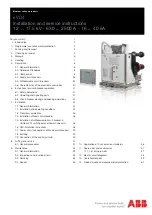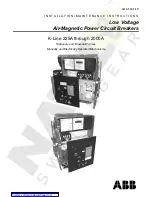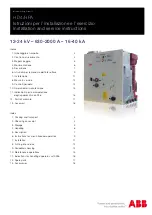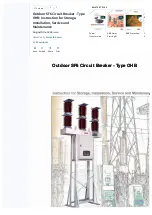
2/49
Circuit breaker TX
3
6000 A
up to 63 A (1 module per pole)
Cat. N° (s) : 4 033 49 to 4 035 68, 4 037 12 to 4 037 78
4. PREPARATION - CONNECTION
(continued)
Connection:
. Inputs and outputs via screw terminals
. Cage terminals, with release and captive screws
. The location of the terminals allows supplying by pin busbar both
sides and fork busbar lower side.
Module maintenance :
. MCBs are equipped with a din rail clamp which facilitates the
removal of the circuit-breaker from the din rail in case of
maintenance or replacement without the need to disconnect the
entire supply line.
A circuit breaker may be replaced in the middle of a supplied fork
busbar row without disconnecting the other products.
This method is available for the 1 pole, 2-poles, 3-poles, 4-poles
devices.
4. PREPARATION - CONNECTION
(continued)
Power supply:
. Either from the top or the bottom
Terminal depth:
. 14 mm
Stripping length recommended:
. 11 mm
Screw head:
. Mixed, slotted and Pozidriv 2.
Tightening torque:
. Recommended: 2.5 Nm.
. Mini: 2 Nm. Maxi: 3 Nm.
Required tools:
. For the terminals: Pozidriv n°2 or flat screwdriver 5.5 mm (6 mm
maximum).
. For fixing: flat screwdriver 5.5 mm (6 mm maximum).
Connectable section:
Copper cables
Without ferrule
With ferrule
Rigid cable
1 x 1.5 mm² to 35 mm²
2 x 1.5 mm² to 16 mm²
-
Flexible cable
1 x 1.5 mm² to 25 mm²
2 x 1.5 mm² to 10 mm²
1 x 1.5 mm² to 25 mm²
Manual actuation of the MCB:
.
Ergonomic 2-position handle
. "I-ON": Device closed
. "O-OFF": Device open
Contact status display:
. By marking of the handle
- "O-OFF" in white on a green background = contacts open
- "I-ON" in white on a red background = contacts closed
Sealing:
. Possible in ʺOpenʺ position (OFF) or ʺCloseʺ position (ON).
Locking:
. By 5 mm padlock (cat. N° 4 063 13) or 6 mm padlock (cat. N° 0 227
97) with padlock support (cat. N° 4 063 03).
Labelling:
. Identification of the circuit by insertion of a label in the label holder.
Technical data sheet: F01547EN/01
Updated: 15/10/2014
Created: 30/05/2014
Unscrew the
terminals
completely
Put the clamp in
the unlocking
position with a
screwdriver
Pull the device
upward
Pull the device
downward in order
to release it
completely from
the prongs of the
busbar. Then pull
the device forward.



































